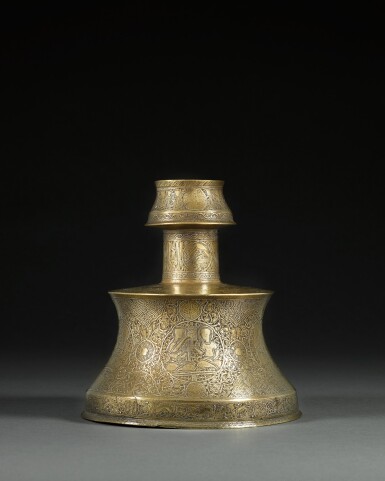Arts of the Islamic World & India including Fine Rugs and Carpets
Arts of the Islamic World & India including Fine Rugs and Carpets

A gold and silver-inlaid brass candlestick, Eastern Anatolia or Jazira, 13th/14th century
Auction Closed
March 30, 12:47 PM GMT
Estimate
20,000 - 30,000 GBP
Lot Details
Description
of bell-form with waisted sides, flattened shoulder and narrow cylindrical neck terminating in a concave moulded socket, engraved and inlaid in silver, the main field of decoration with 5 roundels enclosing court scenes, against a ground densely filled with geometrical roundels and T-fret pattern, the stepped foot with a band of running dogs against scrolls, the neck and socket decorated with an inscription interspersed by circular medallions
20cm. height
The present candlestick belongs to a known corpus of metalwork which has been attributed to Eastern Anatolia and Iraq, notably by the scholars Priscilla Soucek (Soucek 1978, no.70) and Souren Melikian-Chirvani (Melikian-Chirvani 1982, pp.356-7). In his study of a group of candlesticks now at the Victoria & Albert Museum, which share some similar characteristics to the present example, Melikian-Chirvani highlights a number of factors that contribute to an Anatolian attribution, including the fact that they combine technical similarities with stylistic complexity.
The silver T-shape motif present in cusped semi-circles in-between the roundels of this candlestick, is also found on the Blacas ewer, made in Mosul and dated 1232 AD, now in the British Museum, London, inv. no.1866,1229.61; also in a vase dated 1259 AD and now in the Bargello Museum, Florence, inv. no.360 C (published in Curatola 2018, no.212, p.318) and on another candlestick attributed to Anatolia or Jazira, offered in these rooms, 25 April 2012, lot 541.
Most candlesticks bear a calligraphic frieze on the lower base, while fewer are decorated with a band of running animals. An example attributed possibly to Armenia and discussed by Melikian-Chirvani as part of the above-mentioned group, bears a frieze alternating calligraphy and running animals, interspersed by six-lobed rosettes, similarly to the present piece (Melikian-Chirvani 1982, pp.360-3). The smaller geometric gold-inlaid roundels above and below the central cartouches are identical to those found on a candlestick attributed to Siirt, now in the L.A. Mayer Museum of Islamic Art, Jerusalem, inv. no.M 105-69.
